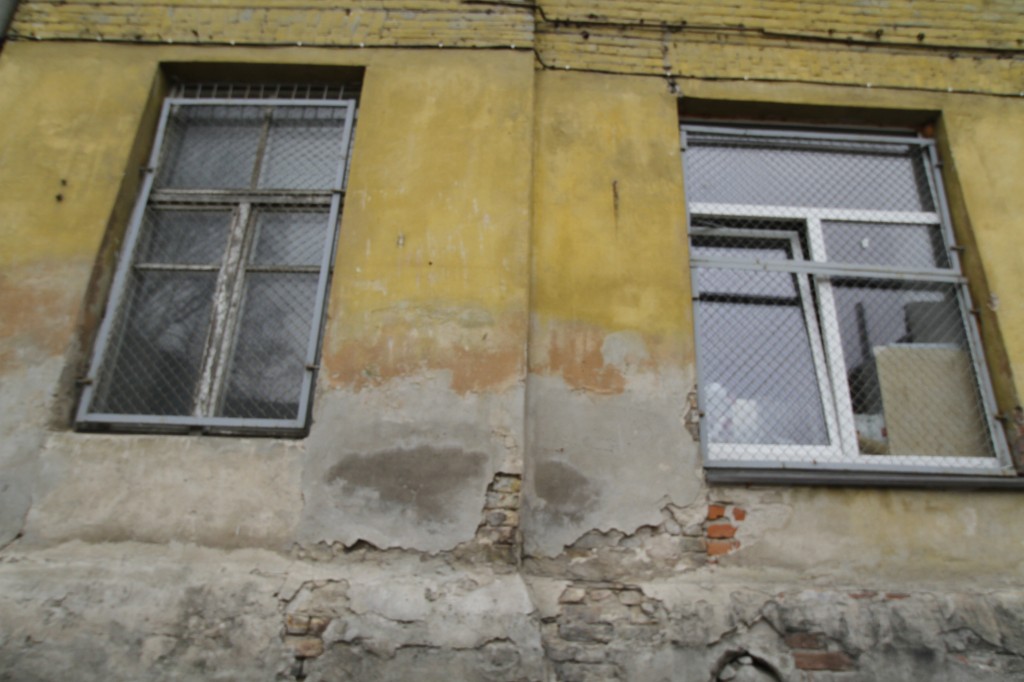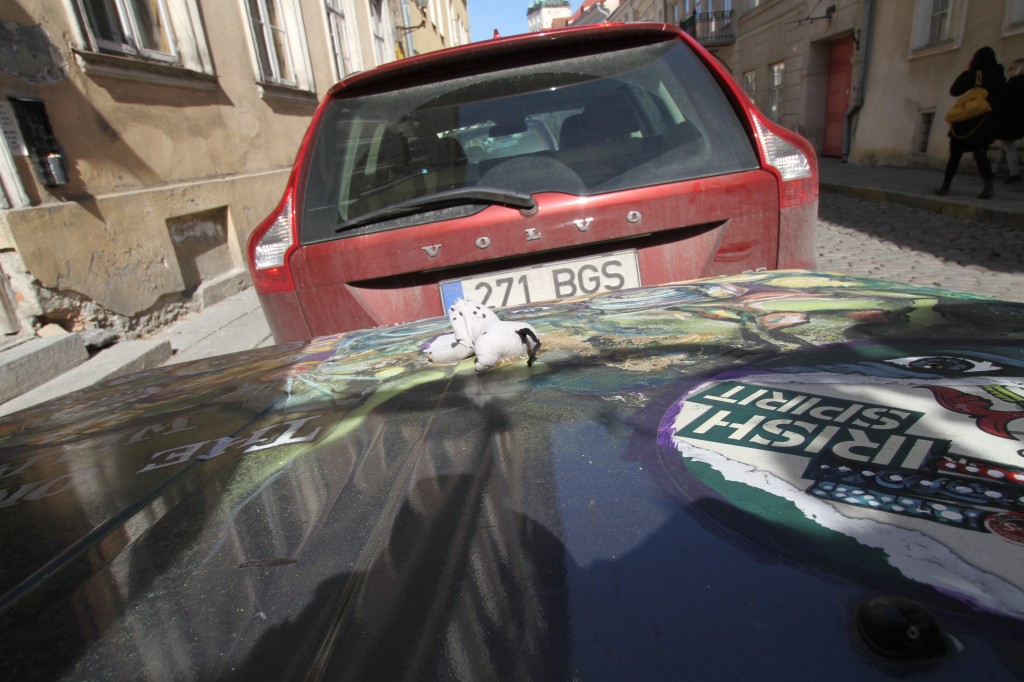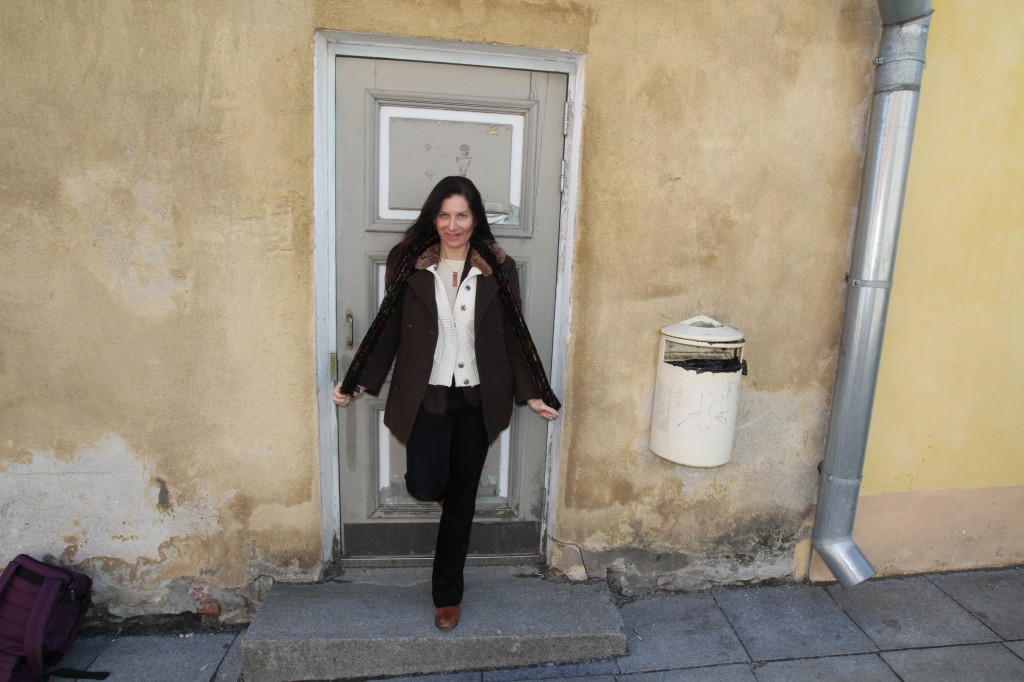I’m lost as I navigate my way through the outskirts of Tallinn, but purposely so, as I know that magic lies in the unknown and what a better way to discover that unknown than to get lost. I flash back to my grandfather who would never hold my hand as we walked through the woods in the dense Adirondack mountains when we embarked on our summer hikes. I know now that I never left his vision although at the time, he made me believe I was on my own after he disappeared out of sight and watched me from behind a tree as panic entered my small face…those youthful child-like eyes searching for his familiar red and blue flannel shirt.
Bringing me out of my comfort zone again and again was something my grandfather loved to do; it was less of a ‘thing’ he did from time-to-time, and more the way he lived his life. It wasn’t until I had long passed my twenties that I realized what a gift he had given me so many years ago despite the fact that to this day, anxiety still swallows me when I lose my way. At times, that anxiety moves to a “fight or flight” place, yet there’s an excitement in that kind of anxiety, for I know that in that unknown place, I’m bound to make some rare encounter or learn some bizarre lesson about some bizarre piece of life I never deemed important before.
I reflect in that memory as I turn another corner, realizing that I left no trace of where I had been nor did I have a clue about where I was going. Having moved beyond the boundaries of the old town at least thirty minutes before, I stopped looking for landmarks I may have read about in some brochure or guidebook, and began to notice what was around me.
It was one of those off-blueish colored moments, where I realized I was pretty far from Kansas, in a part of town where people lived and didn’t deal with tourists as part of their day…not unlike the small town and world where I grew up, they too didn’t fit the storybook culture up until know, I had only read about.
Ever have one of those moments when you return to a place you hadn’t seen in a decade or more and still imagine that life is exactly the same as it had been the day you left? You look for clues, faces, buildings, signs and the guy who served you the ice cream cone on the corner of a street you walked down every day. I was struggling with the notion that Eastern Europe could become as modern and western as the rest of Europe even after over 20 years of independence. The last time I had been this close to Russia was the mid-eighties when I didn’t have permission to have free-flowing conversations with locals nor did they with me, there was a thriving black market, our hotel rooms were bugged, shops were stark and restaurant menu offerings were slim.
Even my return visit to Budapest and Prague a couple of summers ago didn’t convince me that everything had transformed even though I could rent a segway, buy a t-shirt with the city plastered on it and order fine wine. If that wasn’t enough, every newspaper, history book and photograph proved that it was all very real and we were now living in very different times.
And yet, like the abolishment of slavery didn’t transform America’s attitudes about how blacks should be treated after 20 years, you can’t remove the impact of more than a century of tyrant rule and communist life in one generation. Like many cultures in Eastern Europe, Estonians didn’t always rule their own land. In fact, for over 800 years, the Swedes, the Poles, the Danes, the Germans and the Russians have all invaded the country and put down a stake. I learned through my visits to Kolga and Sagadi Manors that the Scandinavians and Germans held fort for many years while Estonians served them tea and watered their gardens. While they enjoyed stints of freedom — for two short years in the 1200s — and for 19 years in 1920, not ruling their own land has been more common than ruling it.
Not being given control of your own destiny time and time again must play a toll on one’s attitudes, personality & outlook on life I thought as I wandered aimlessly down yet another street, one that didn’t seem to have a visible street sign. I also thought about what else I knew about Estonians aside from the factoid that my fellow travelers were most thrilled about: Estonia is the most connected country in Eastern Europe. Aside from connectivity, the other topic that came up again and again was the one that breaks up countries, marriages, families and cultures: Religion.
You can’t go to many places in Europe and not be inundated with churches and people’s fixation with them. Yet, Estonia is apparently the least religious country on the planet with Ireland, Poland and Greece being the most religious…at least in Europe.
In talking to a few locals in the first few days, the proof was there. Women in their twenties and thirties both told me they didn’t go to church nor did they grow up believing in a God. 80% of the same group of women said that they didn’t feel the need to marry their partner even if they wanted to have children.
Like we do when we want evidence of stereotypes to show up in our face, I looked for more irreligious types on my walk, as if they’d somehow show such a trait in their walk or attire. I remembered the live strip show on Viru Street I had passed on my way out of town, red satin dots across fake diamond studded banners fell in and around the Golden Dolls Gentleman Club, where they hold shows every day from 10 to 6. It was next to a Veta clothing store, Restaurant Cru and a Baltic amber shop, one of the dozens you’ll find on any street in Tallinn. This wasn’t quite the evidence I was looking for however, nor did it support my theory that more remnants from pre-Soviet days were still around moreso than tour guides would have you believe.
I, for one, would have loved to sit down with an 80 something year old male Estonian and drill him on every decade of his life, from his job, the wars, his military duty, his experience with Russian soldiers, how he provided for his family then and now, what his daughters thought they would become at ten and who they are today, politics, the environment, education and every miniscule detail in between.
Lacking a victim born in 1924 to sip coffee with for the afternoon, I continued walking. Urban shops and signs gave way to more stark buildings, some white washed and gray with weathered textures that wove in soft pinks, oranges and yellows in that antiquated way that old stone buildings display after a century of wear and tear. Olive green paneling is plastered across the top of a turn of the century stone building and graffiti in more than one language decorates the bottom half.
Two smoke stacks protrude into the sky ahead of me, one with a red stripe I can barely make out in my hazy view, one which suddenly feels more surreal than what actually just met the eye. A woman in a bubble gum pink coat wearing matted gray rubber shoes with furry tops, stands with her son at a bus stop. She has a faux leather bag with keys dangling from a worn-out fringe and she looks away from her son while she takes a puff from her cigarette, as if doing so will increase the likelihood of the 36 bus coming faster.
While in the country, they spoke of mushroom farms, Juniper forests and limestone gravestones, in Tallinn’s greater urban-ness, I learn about relics from the past, savory dishes that are more meaty than not, amber and the the attitude dynamic that exists between a not-so-wide generation gap. I chalk up a conversation with a man in his forties standing a few feet away from my pink-clad woman with the cigarette dangling from her mouth, now on her third and there are still no signs of the bus. His English isn’t fluent, yet we can communicate and his blue sparkling eyes which exuded generosity and authenticity in double doses, were enough to make up for whatever word or phrase that might present a communications challenge.
Not knowing what bus he was waiting for or if he was waiting for one at all, I figured that I didn’t have much time to start the conversation with trivial chit chat and work my way up to what I was really wanting to know. So, rather than begin with “Is it always this cold in Estonia in April?” especially since I had already heard countless times that this was an unusually cold year, I dove right into a question about his life as a teenager and oh btw, what were your twenties like while we’re heading down that path? Luckily, he didn’t think I was some American stalker or loopy redhead hitting on him on a random Thursday afternoon.
Andrus used to drive a military truck and spent time as a night sniper, oddly not the first one I had met since I arrived in Estonia. The Soviet army brought him to Moscow for training when he was just 18 and as he drifted off into memory lane, I learn that he was brought to the “KGB House” twice during his two and a half year stint with the Russians. Afterwards, he was given an offer to stay where he’d receive a one room apartment and a black Volga or return home to a small town an hour or so from Tallinn. He chose the latter wondering if that choice might land him in Siberia instead, for who knows how much was required to demonstrate one’s loyalty to the Party way back when.
As he shares his stories with me, I take in the volume of graffiti adorned on two century-old buildings across the street, while the structure next to it meets me with a mixture of urban decay and remnants from a Soviet past. Signs in a language that look as unfamiliar as Klingon might; Mustikas, Karamika, Infoveva, Euro Vaistine line up next to brightly colored plastic bubbles, where I think locals might dump their recyclables.
I move on and lose myself for awhile until the word Turg presents itself, a sign that is next to or part of a long blocked off area with a plastic cover draped over its top. The ceiling has ripples of sorts, a flimsy covering that barely seems as if it could give the people below it shelter if the sky should open up. I can see that it’s a market of sorts…..flowers, fruit and vegetable stalls face me mostly in open air, yet the stall tellers don’t flinch despite the beckoning of rain. Cars lined up on sidewalks in front of the shops without any logical reason given the volume of open parking spots scattered nearby. Bright colored clothing with over the top costume jewelry is the fashion order of the day, their glitter too much for the eye to bear against its otherwise stark background…I can see the glare from the shine echoing through the windows. Most of the shops appear to be closed yet the cars linger….another mystery in a mysterious land.
In these near suburbs of Tallinn, I don’t see architectural evidence of the Gothic, Baroque and Rococo styles that swept through the centuries and still remain in tact at some of the country manors and estates. I see a Tallinn struggling with its past and its present, trying to figure out its future, one where East not just meets the West, but embraces it with fortitude. I continually met welcoming hospitable people, inside the city and out, eager to protect their heritage and history even if that history didn’t include a religion or two that mattered. They are if anything resilient. Moving. Intriguing. Reserved and yet warm. Authentic.
It was an Estonia I wanted to return to and as I decided it was time to navigate my way back to more familiar streets as the light began to fade, I bid farewell to the part of town where locals lived not worked, smiling into the distance and thinking: this was a trip worth taking.
Note: I didn’t take many photos as I ventured out of the old town center, so these are selected shots taken in and around Tallinn’s old town.

Renee Blodgett is the founder of We Blog the World. The site combines the magic of an online culture and travel magazine with a global blog network and has contributors from every continent in the world. Having lived in 10 countries and explored over 90, she is an avid traveler, and a lover, observer and participant in cultural diversity. She is also the founder of the Magdalene Collection, a jewelry line dedicated to women’s unsung voices and stories, and the award-winning author of the bestselling book Magdalene’s Journey
She is founder of Blue Soul Media and co-founder of Blue Soul Earth as well as the producer and host of the award-winning Blue Soul CHATS podcast, that bridges science, technology and spirituality. Renee also founded Magic Sauce Media, a new media services consultancy focused on viral marketing, social media, branding, events and PR. For over 20 years, she has helped companies from 12 countries get traction in the market. Known for her global and organic approach to product and corporate launches, Renee practices what she pitches and as an active user of social media, she helps clients navigate digital waters from around the world. Renee has been blogging for over 16 years and regularly writes on her personal blog Down the Avenue, Huffington Post, BlogHer, We Blog the World and other sites. She was ranked #12 Social Media Influencer by Forbes Magazine and is listed as a new media influencer and game changer on various sites and books on the new media revolution. In 2013, she was listed as the 6th most influential woman in social media by Forbes Magazine on a Top 20 List.
Her passion for art, storytelling and photography led to the launch of Magic Sauce Photography, which is a visual extension of her writing, the result of which has led to producing six photo books: Galapagos Islands, London, South Africa, Rome, Urbanization and Ecuador.
Renee is also the co-founder of Traveling Geeks, an initiative that brings entrepreneurs, thought leaders, bloggers, creators, curators and influencers to other countries to share and learn from peers, governments, corporations, and the general public in order to educate, share, evaluate, and promote innovative technologies.












